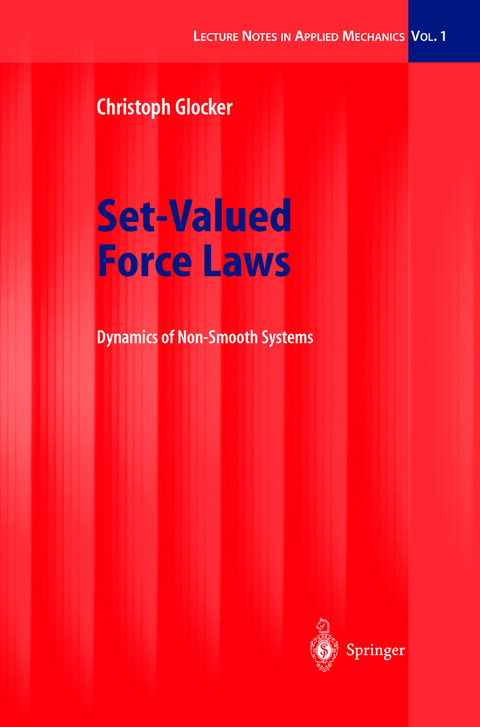
Set-Valued Force Laws
Springer Berlin (Verlag)
978-3-540-41436-0 (ISBN)
As one of the oldest natural sciences, mechanics occupies a certain pioneering role in determining the development of exact sciences through its interaction with mathematics. As a matter of fact, there is hardly an area in mathematics that hasn't found an application of some form in mechanics. It is thus almost inevitable that theoretical methods in mechanics are highly developed and laid out on different levels of abstraction. With the spread of digital processors this goes as far as the implementation in commercial computer codes, where the user is merely con fronted on the surface with the processes that run in the background, i. e. mechan ics as such: in teaching and research, as well as in the context of industry, me chanics is much more, and must remain much more than the mere production of data with the help of a processor. Mechanics, as it is talked about here, tradition ally includes a wide spectrum, ranging from applied mechanics, analytical and technical mechanics to modeling. and experimental mechanics, as well as technical realization. It also includes the subdisciplines of rigid body mechanics, continuum mechanics, or fluid mechanics, to mention only a few. One of the fundamental and most important concepts used by nearly all natural sciences is the concept of linearization, which assumes the differentiability of mappings. As a matter of fact, all of classical mechanics is based on the avail ability of this quality.
1. Introduction.- 1.1 Friction Laws.- 1.2 Literature Survey.- 1.3 Subjects and Contents.- 2. Fundamental Concepts.- 2.1 Internal and External Forces.- 2.2 The Law of Interaction.- 2.3 The Dynamic Equilibrium.- 2.4 The Virtual Work of a Dynamic System.- 2.5 Resultant Force and Inertia Terms.- 3. Rigid Body Systems.- 3.1 Preliminaries on the Vector Product.- 3.2 Rigid Body Kinematics.- 3.3 Rigid Body Kinetics.- 3.4 The Dynamic Equilibrium of a Rigid Body.- 3.5 The Virtual Work of a Rigid Body System.- 3.6 Classical Bilateral Constraints.- 3.7 Generalized Coordinates.- 4. Motion and Discontinuity Events.- 4.1 Preliminaries on Integration of Functions.- 4.2 Displacements, Velocities, and Accelerations.- 4.3 Restriction to Finite Numbers of Discontinuities.- 5. Displacement and Velocity Potentials.- 5.1 Directional Newton-Euler Equations.- 5.2 Set-Valued Force Laws.- 5.3 Scalar Potential Functions.- 5.4 On the Modeling of Force Laws.- 6. Representation of Scalar Force Laws.- 6.1 Decomposition into Unilateral Primitives.- 6.2 Variational Formulations and Upper Subderivatives.- 6.3 The Convex Case: Conjugate Potentials and Duality.- 6.4 Force Elements in Engineering Dynamics.- 7. Force Laws on Different Kinematic Levels.- 7.1 Continuity Properties of the Trajectories.- 7.2 Displacement Force Laws on Acceleration Level.- 7.3 Velocity Force Laws on Acceleration Level.- 8. Index Sets and LCP-Formulation.- 8.1 Index Sets.- 8.2 Formulation on Different Kinematic Levels.- 8.3 The Linear Complementarity Problem.- 8.4 The Dual Principle of Least Constraints.- 9. Principles in Dynamics.- 9.1 The Principle of Least Constraints.- 9.2 The Principle of Gauß.- 9.3 The Principle of Jourdain.- 9.4 The Principle of d'Alembert/Lagrange.- 9.5 Remarks on d'Alembert/Lagrange's Principle.-10. Spatial Coulomb Friction.- 10.1 Geometry of Surfaces.- 10.2 Contact Kinematics.- 10.3 Kinetics.- 10.4 Contact Laws.- 10.5 Sliding Contacts.- 10.6 Friction Pyramid for Rolling Contacts.- 10.7 Friction Cones and NCP Formulations.- 10.8 A Differentiable NCP for Rolling Contacts.- 10.9 Example and Remarks.- 11. Velocity Jumps due to C0-Constraints.- 11.1 On Impacts in Mechanical Systems.- 11.2 Mechanical Model and Problem.- 11.3 Bilaterally Constrained Motion.- 11.4 Velocity Jump by Time-Scaling.- 11.5 Velocity Jump by Reflection.- 11.6 Reflections and Collisions - Remarks.- 12. Electropneumatic Drilling Machine.- 12.1 Mechanical Model.- 12.2 Simulations.- 13. Percussion Drilling Machine.- 13.1 Mechanical Model of the Drilling Machine.- 13.2 Mathematical Model for Non-Contact.- 13.3 The Contact Model.- 13.4 State Transitions.- 13.5 Results.- 14. Turbine Blade Damper.- 14.1 The Damper Model and the Non-Contact Case.- 14.2 Contact Kinematics of the Damping Device.- 14.3 Numerical Results.- 15. Concluding Remarks.- References.
| Erscheint lt. Verlag | 22.5.2001 |
|---|---|
| Reihe/Serie | Lecture Notes in Applied and Computational Mechanics |
| Zusatzinfo | IX, 222 p. |
| Verlagsort | Berlin |
| Sprache | englisch |
| Maße | 155 x 235 mm |
| Gewicht | 612 g |
| Themenwelt | Mathematik / Informatik ► Mathematik ► Wahrscheinlichkeit / Kombinatorik |
| Naturwissenschaften ► Physik / Astronomie ► Mechanik | |
| Technik ► Maschinenbau | |
| Schlagworte | Drilling • Force Laws • Kraft (physikal.) • Mechanik • Model • Modeling • Optimization • rigid body • Rigid Body Systems • Set-valued Force Laws • Simulation |
| ISBN-10 | 3-540-41436-3 / 3540414363 |
| ISBN-13 | 978-3-540-41436-0 / 9783540414360 |
| Zustand | Neuware |
| Haben Sie eine Frage zum Produkt? |
aus dem Bereich


